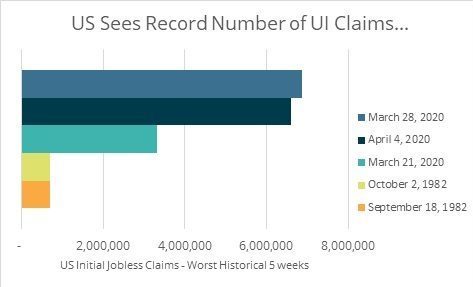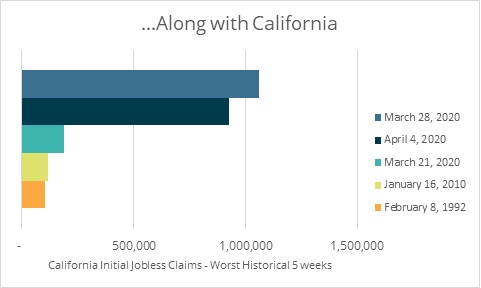We’ve seen and heard the unemployment numbers. But what does all of this really mean for our economic recovery in San Diego? Welcome to the ‘economy in crisis’ series – a bi-weekly breakdown of data at the national, state, and local level in the shadows of Covid-19.
A survey of local businesses shows that the impacts of the COVID-19 outbreak on San Diego’s economy are vast, amidst signs of resiliency. These results are corroborated by official data, both nationally and in California.
The survey will remain open, and results will be used to track business sentiment over time. To take the survey, please click here.
UNEMPLOYMENT: WHAT THE DATA Is (AND Isn’t) SAYING
United States

According to the Labor Department, initial claims for unemployment insurance have skyrocketed across the US in recent weeks. Claims jumped to 3.3 million for the week ending March 21 and more than doubled the week after, topping 6.8 million. Both weeks smashed the previous record of 695,000 new claims in 1982. The monthly tally of 10.7 million in March 2020 is nearly 3.5 times the number of claims filed in May 2009, the worst month of the Great Recession. Claims also appear to be poised for another record-breaking month, with another 6.6 million reported for the week ending April 4.
California

Closer to home, new filings for unemployment in California increased to 186,000 for the week ending March 21 and topped a million for the week ending March 28, eclipsing the previous record of 115,000 claims before the COVID-19 outbreak. Initial claims “eased” somewhat to 925,000 in the week ending April 4, but like the national figure, remain substantially elevated.
With such a meteoric rise in the number of claims being filed, it is likely that state labor agencies, including the California Employment Development Department, are struggling to immediately process them all, which would lead to a lower number of claims initially being reported. This suggests a much higher number of claims will be reported in the coming weeks as backlogged applications are processed and may make it somewhat more difficult to determine the point where stress in the job market begins to subside if the system is still processing backlogged applications after actual claims have begun to decline. Nonetheless, the trend is unmistakable: like the rest of the nation, a record number of Californians are filing for unemployment, in line with the survey results provided by local businesses.
San Diego
Unfortunately, unemployment insurance data is not reported at the metropolitan or county level, and San Diego job market data is reported on a roughly four-week lag – March employment estimates for San Diego will be available from the Bureau of Labor Statistics (BLS) on April 29. However, it is expected that the estimates made available by the BLS in the coming months will paint a bleak picture of the local job market given the sharp spike in unemployment benefits across the state, and the local prevalence of eating and drinking establishments, retailers, wholesalers, and entertainment venues, which have all been disproportionately impacted by the outbreak of COVID-19. Together, these industries accounted for about one in four local jobs and $18.5 billion in salaries and wages in 2019—jobs and income that are now at risk during the pandemic and likely to see large reductions in upcoming job reports. Also, given the deep roots of those industries in the local economy, the ripple effects of job losses would be significant: for every 1,000 jobs lost in retail, wholesale, the arts, or food services, an estimated 500 jobs would be lost in other industries across San Diego.
A Silver Lining
Unlike most downturns precipitated by economic or market imbalances, this downturn was brought on by a non-economic, Black Swan event during an otherwise healthy economic expansion. At 3 percent, San Diego’s unemployment rate was well below the state and national averages, local earnings were climbing at a healthy pace, and the housing market was flourishing.
Given the strong economic conditions in San Diego before the outbreak, chances are good that the economy could bounce back fairly quickly, especially once travel and tourism come back nationally. However, timing will be key in determining the pace at which local businesses recover once this is over. The more economic pain endured right now as communities limit the spread of the virus, the better the chances of a full and speedy recovery. Conversely, the recovery could be much slower if the virus is not effectively contained, and local businesses and households are forced to draw on lines of credit for extended periods of time to weather the downturn.
COVID-19 Recovery Resources
Regardless of how this all plays out, EDC is here to help.
For general COVID-19 recovery resources and information, please view this page.
You also might like: